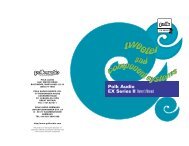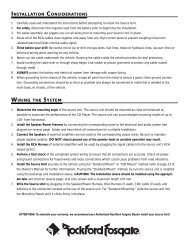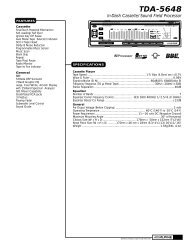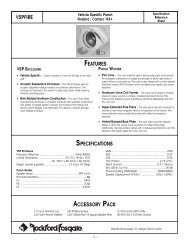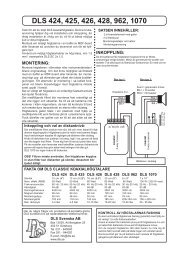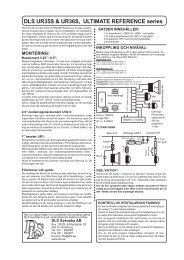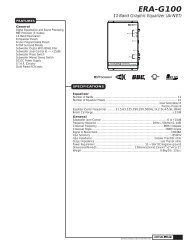®because they are small compared to the wavelengths involved, and to be quite directionalat high frequencies because they are large compared to these smaller wavelengths. Referringto figure 5, the directional loudspeaker can represent a horn tweeter or a planarspeaker such as an electrostatic. The non-directional speaker could be a dome tweeter, butalso represents the situation for low frequencies radiated by almost any woofer. Thereforeit is difficult to control poor room acoustics by using directional speakers because most ofthe resonance problems in rooms occur at low frequencies.)One might think that a listener would find a flat free-field response to be ideal, and thismight be true in most rooms if he listened at one meter from the speaker. This of course isseldom desirable or possible. As the listener moves farther from the speaker, closer to thereverberant field of the room, the perceived frequency response changes, and always forDirectional LoudspeakerFigure 5Non-directional Loudspeakerthe worse. The speaker will excite various standing waves of the room depending onwhere it is located. If it is in a room corner, it will of necessity excite all the standingwaves. If it is placed out from the walls a few feet and not close to a corner it will selectivelyexcite those standing waves which have maxima near the speaker. (A sound sourcelocated at a minima of a standing wave will not excite that particular resonance verymuch. If the minima were truly a null, it would not be excited at all.) Therefore, thelocation of the speaker in the room has a great deal to do with how much energy it putsinto the room as a function of frequency.10
®In particular, the proximity to reflecting surfaces greatly affects the efficiency with whichlow frequencies are radiated. A corner location provides the most low-frequency energy,and a side wall location provides somewhat less, while a location away from walls providesthe least. Some loudspeakers are designed to be flat when in a corner or against awall, while others are designed for mounting away from these surfaces.Remember, however, the standing wave pattern in any room is determined by the roomdimensions only, and does not change if the speaker is moved around. Loudspeakerplacement can only affect the relative degree to which various resonances are excited.Also, for any given loudspeaker location, the perceived frequency response dependsgreatly on the location of the listener. If one is sitting near the maximum of any standingwave, that frequency will be accentuated. It follows that if a speaker is in a corner and thelistener is in the diagonally opposite corner, both will be at maxima for all standing waves,and the most efficient perceived low-frequency response will be attained. Such a listeningposition has many other disadvantages, however!Attacking The ProblemIt might seem that any listening situation could be corrected to have ideal frequencyresponse simply by applying corrective electrical equalization in the sound system. This,however, is an oversimplification. The perceived frequency response of a sound systemdepends strongly on the speaker location and the listener location. For one listener positionand speaker position, equalization can provide flat response for steady-state signals.The term “steady state” is important. Remember that standing waves are formed byreflections back and forth between parallel surfaces. It therefore takes a little time forthese standing waves to build up. The listener to a sound system, however, hears thedirect sound from the speaker first, before any reflections take place. This direct soundwill not be contaminated by standing waves, and if the loudspeaker has flat free-fieldresponse, after equalization, the first sound arriving at the listener will be uniform inresponse. Only later will the overall response take on the coloration caused by the roomitself. It so happens that the ear is particularly sensitive to the first sound it hears, andtends to judge a sound’s overall quality by the uniformity of the direct sound. Therefore,even though a large amount of equalization can correct for a very strong maximum orminimum from standing waves, the correction will be applied to the direct sound where itis not needed, and the timbre of the sound may be distorted. For this reason, equalizationmust be used carefully, and always must be adjusted by listening to the results and notrelying exclusively on instruments such as sound level meters to determine “flat” response.11




